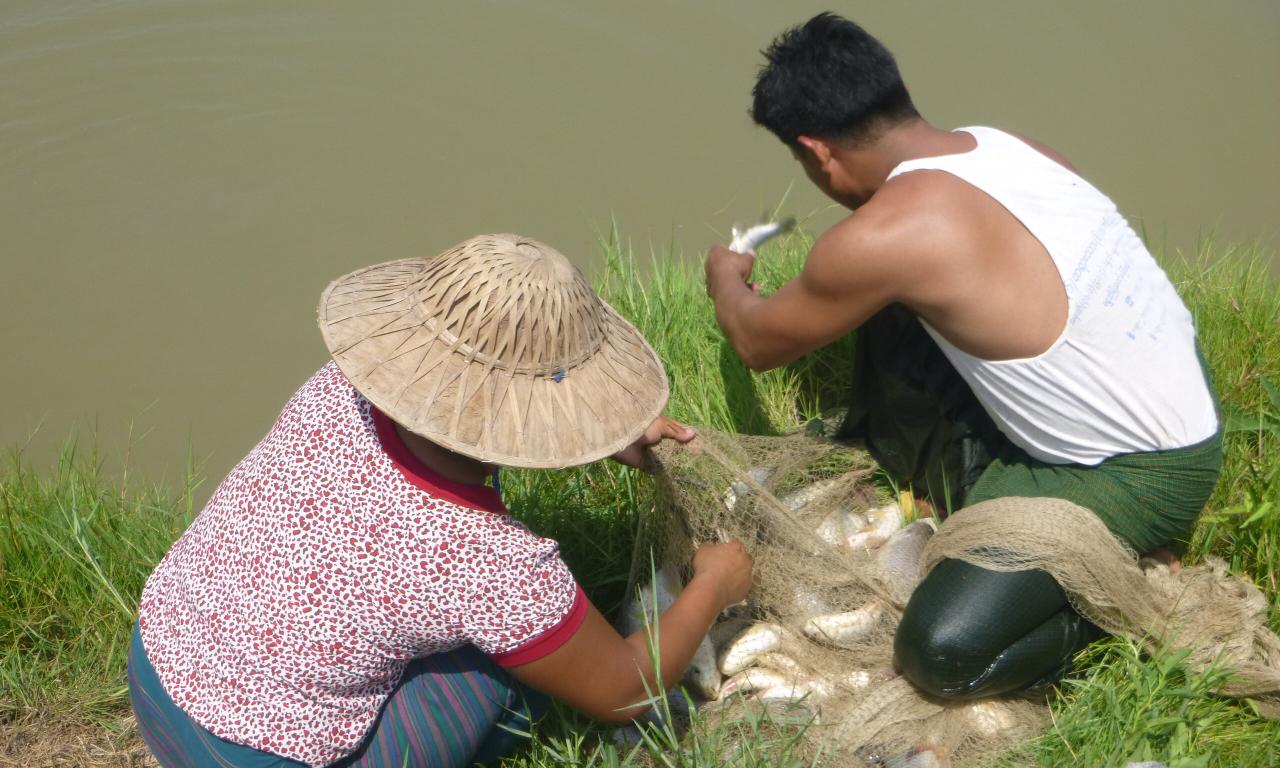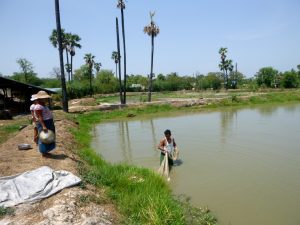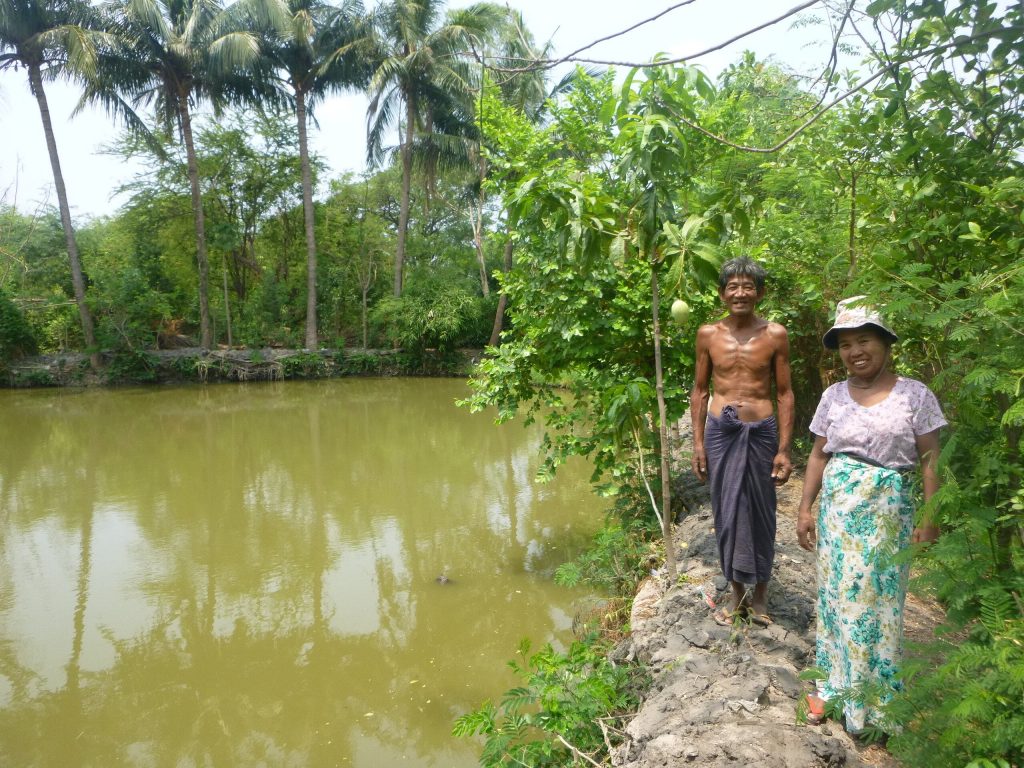
Myanmar is one of the largest fish producers in the world. The country ranks among the largest global inland aquaculture producers. With increased understanding and investment in sustainable development, Myanmar’s aquaculture sector has the potential to reduce poverty and contribute to national food and nutrition security.
In order to build evidence on aquaculture in the country, a new small-scale fish farmer study sheds light on the market dynamics faced in two villages of Shwebo Township, located approximately 80 km northwest of Mandalay city, in the north-west of the country. Research participants were collaborating farmers of the Myanmar Sustainable Aquaculture Program (MYSAP) in Hta Naung Wun and Shwe Baw Kyun villages.
The study revealed with small improvements in practices aquaculture could boost productivity, food, and nutrition security of small-scale fish farmers. Participants interviewed had on average 10 years working in aquaculture, however, many reported they turned to alternative sources of income outside aquaculture including rice farming. Working as employees or traders in non-aquaculture sectors, such as weaving, play a key role in household income generation. Between May 2018 to May 2019, they reported selling only the large-sized fish and used smaller-sized fish caught mainly for family consumption.
The main aquaculture production system in the study area was in earthen ponds located near the households with a polyculture of mixed fish species. An earthen pond is a water body that is enclosed by the earth. The constructed structure normally has an inlet and outlet for water. The farmers sold rohu, Nile tilapia, common carp, pacu, silver barb, mrigal, and indigenous catfish. Despite living relatively close to fresh fish markets, the participants reported selling almost exclusively to processing companies.
The study showed fish farmers are interested in repairing or modifying their ponds, as well as increasing the size of the final harvested fish product. The main challenges reported were the high cost of fish feed and climatic conditions which impact primarily on water availability. Climatic conditions can have a detrimental impact on production. When drought or flooding occurs, the farmers said they were forced to sell their fish early regardless of the fish size.
The main water source in the studied area was the Mahar Nandar Lake, which receives water from the Tha Phan Sate dam, the biggest dam in the country. Hta Naung Wun village had good water access but one of the main threats in the area was flooding during the rainy season. The village has experienced flooding events with negative consequences on fish production. Fish farms in Hta Naung Wun use water pumps for around 2-3 months per year. On the other hand, Shwe Baw Kyun village receives water from the Kopin reservoir, which takes water from the Mahar Nandar Lake. It is prone to water shortages and temporary drought. Therefore, fish farmers use water pumps for around 5 months each year during the dry season to maintain the water level in their ponds.
The MYSAP program supports small-scale fish farmers in these villages to improve productivity and resilience through training sessions, fingerling distribution, and the installation of feed mills, delivered to direct beneficiary households in partnership with the international development organization BRAC Myanmar.

Opportunities for boosting small-scale aquaculture in Shwebo Township
Based on the interviews the study identified the following potential opportunities:
- Opportunity to improve water access: To reduce the negative impact of water access fluctuation, available water pumps can be used to maintain pond water level. The provision and supervision of the usage of some water pumps might mitigate the effects on the production. It is important to note that the efficiency of the use of water pumps should be tested before broadly implementing it since the effectiveness of the usage of this technology depends on each local context. In addition, the intervention of the local government is required for the development of public infrastructure to guarantee adequate water supply.
- Opportunity to increase collective action among fish farmers: Encouraging collective actions among fish farmers would likely provide benefits including increased bargaining power, coordination of harvest times, access to markets, and bulk purchasing of inputs to access lower prices. Increased collective action might improve access to affordable fish feeds. The implementation of the bulk purchase of raw materials to make fish feed can reduce the cost of this major pond input.
- Potential to implement post-production activities: Fish farmers might implement post-production activities to add value to the product. This may also reduce the dependency on other market actors like processors when trading harvested fish. The production of frozen fish or minced fish balls is limited in Shwebo because of the frequent electricity cuts, and this is an even greater constraint in rural areas. One alternative might be the production of dried salted fish. However, it would be important to verify if the production and local sale of dried fish would negatively impact farmers’ profit margin from fresh fish sales.
Measuring perceptions of the MYSAP program
Based on the interviews the study identified potential challenges and perceptions on the MYSAP program to ensure access to production inputs. The support of the MYSAP program is turning aquaculture into a more productive activity with the implementation of technologies for smallholder farmers. Farmer perceptions on MYSAP support, delivered by BRAC Myanmar staff, gathered by the study include:
- Perception concerning the access to fingerlings: The fish farmer participants perceived that the free fish fingerling provision component was a key factor that ensures their access to relevant aquaculture inputs. During interviews, 61 percent of the participants perceived the MYSAP program has an essential role in improving access to fingerlings.
- Perception concerning the access to training: The role of the program to ensure access to training sessions was positively weighted. Fifty-four percent of participants rated the role of the program as important to access training sessions, while forty-six percent rated it as essential.
- Perception concerning the access to fish feed: Ninety-two percent of the participants rated MYSAP’s role in improving access to fish feed as slightly important. This result relates to the fact that the feed mill equipment was only installed in March 2019, at the end of the culture season, when some farmers had already harvested. It is expected that farmers will obtain benefits from the use of the feed mill equipment in the coming culture seasons. During the field research, it was found that farmers did not clearly understand the procedure for benefitting from the MYSAP funded feed milling equipment. Don Griffiths, MYSAP Inland Team Leader has confirmed that BRAC Myanmar staff have since better communicated the purpose of MYSAP feed milling support and how the benefits will be shared by collaborating participants.

Acknowledgments:
MYSAP is funded by the European Union (EU) and the German Federal Ministry for Economic Cooperation and Development (BMZ) and is implemented by Deutsche Gesellschaft für Internationale Zusammenarbeit (GIZ) GmbH and Myanmar Department of Fisheries. WorldFish Myanmar is realizing MYSAP’s inland component under a GIZ grant agreement, with Ar Yone Oo, BRAC Myanmar, and Malteser International as sub-contracted implementing partners.